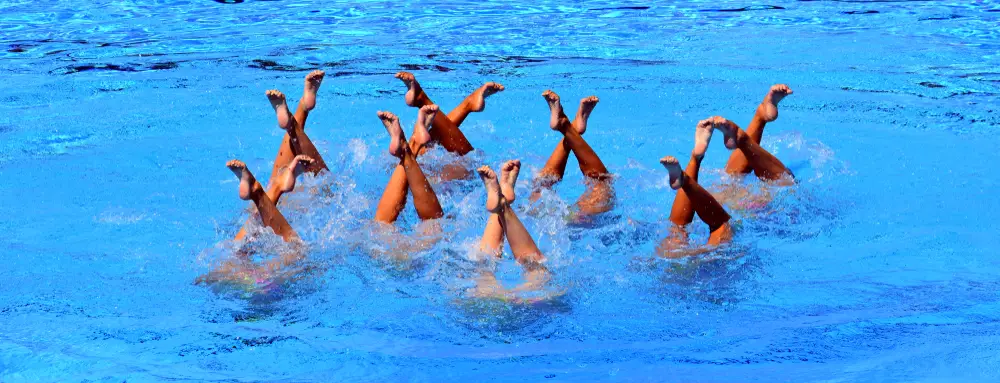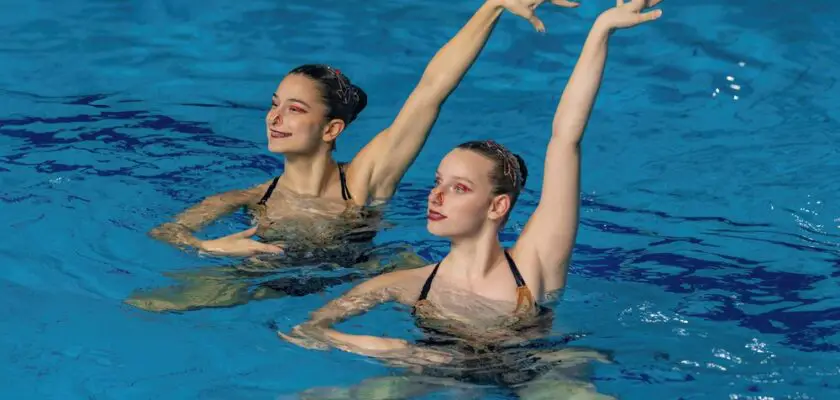Synchronized swimming is a sport that combines swimming, gymnastics and dance, all in a swimming pool. In the sport, athletes perform choreographed routines to the sound of music, demonstrating strength, flexibility, endurance and a lot of technical precision, of course.
Synchronized swimming was born in the 1930s and quickly evolved to become one of the most challenging sports in the world, even earning a place in the Olympics. But practicing the sport is not at all simple, so it has very strict rules.
The rules of synchronized swimming range from the structure and dimensions of the pool, the duration of the routines, the scoring system and the number of participants, to the infractions and penalties that can be applied.
So check out the rules of synchronized swimming and stay up to date with the sport!
Open your Betano account and get up to 1,000 reais in bonuses.
PIX payments, live games and super odds!
Click here to open your account!

Synchronized swimming rules: complete list
- Swimming pool;
- Routines;
- Scoring;
- Competitors;
- Compulsory figures and free routines;
- Equipment and costumes;
- Infractions and penalties.
Synchronized swimming rules: swimming pool
The pool used for synchronized swimming must be at least 25 meters long by 12 meters wide, with a minimum depth of 3 meters throughout.
This guarantees enough space for swimmers to perform complex movements and jumps without the risk of injury.
In addition, the competition area must be clearly marked on the surface of the water, and the edge of the pool must be safe, with no protrusions or obstacles that could interfere with performances.
The water must be kept at a temperature of between 25 and 28 degrees Celsius, thus ensuring the athletes’ comfort during long training and competition sessions.
Synchronized swimming rules: routines
In synchronized swimming, routines are divided into two types: technical routines and freestyle routines. Each has a specific duration, find out more:
- In the technical routines, the time can vary between 2 minutes and 30 seconds to 3 minutes and 30 seconds, depending on the category (solo, duets or teams).
- The free routines have a duration that can vary from 3 minutes to 4 minutes for solos, and from 4 minutes to 5 minutes for duets and teams.
These times include the time to enter the water and the execution of the choreographed movements. Exceeding or failing to meet the stipulated time can result in penalties, which are deducted from the final score.
Synchronized swimming rules: scoring
The score in synchronized swimming is calculated based on three main factors: execution, artistic impression and degree of difficulty.
Each of these factors is assessed by a panel of judges, who give scores from 0 to 10. Here’s how the process works!
- Execution: execution will assess the precision and technical quality of the movements performed by the athletes.
Technical errors, such as misalignments and lack of synchronization, will result in deductions.
- Artistic impression: Here, creativity, musical interpretation and the overall presentation of the routine will be considered.
The cohesion of the choreography and the artistic expression of the swimmers are essential for a high score.
- Degree of difficulty: will measure the complexity of the movements and the transitions performed.
The more challenging the movements, the higher the potential score, provided they are executed correctly.
Synchronized swimming rules: competitors
Synchronized swimming can be performed in different categories, so there is a variation in the number of participants.
Here are the most common categories:
- Solo: happens with a single swimmer performing the routine.
- Duet: two swimmers perform the routine together and, of course, synchronized.
- Team: a team is made up of eight swimmers, who perform the routine synchronized.
In addition to these, there are combined categories, such as the Highlight, in which up to 10 swimmers take part, performing a routine that highlights special skills and outstanding movements.
In mixed competitions, male swimmers are also included, increasing the diversity and complexity of the routines.
Synchronized swimming rules: compulsory figures and freestyle routines
Synchronized swimming competitions include the execution of compulsory figures and free routines. Here’s what that means:
- The mandatory configurations are standardized movements that all athletes must perform, allowing for a more objective assessment of their technical skills.
- In the free routines, the athletes have greater freedom to create original choreographies that demonstrate their artistic and technical abilities. This category allows for greater individual expression and innovation, and is one of the most eagerly awaited by those watching.
Synchronized swimming rules: equipment and costumes
The equipment used in synchronized swimming is very specific. Check it out!
Swimmers should wear appropriate swimwear, which is neither transparent nor excessively revealing. It is common to wear outfits with elaborate designs that complement the theme chosen for the routine.
In addition, the use of waterproof make-up is permitted to enhance the swimmers’ facial expressions, which is very important for the artistic impression of the sport.
The use of headbands, hairpins and other accessories is quite common, and they must be securely fastened to prevent them from coming loose during the performance.
Synchronized swimming rules: infractions and penalties
Infractions in synchronized swimming can occur for a variety of reasons, the main ones being technical faults, disregard for timing rules and violations of costume regulations.
Penalties are then applied according to the severity of the infraction and can range from deductions in the score to disqualification of the team.
Here’s how the penalties work for each infraction:
- Exceeding the routine time limit: penalty of 0.5 points for every 5 seconds over.
- Inappropriate use of costumes: deduction of up to 2 points.
- Lack of synchronization: deduction proportional to the error observed.
The judges have a responsibility to apply penalties to the athletes’ routines, but always in a fair manner.

Synchronized swimming rules: complete list
- Swimming pool;
- Routines;
- Scoring;
- Competitors;
- Compulsory figures and free routines;
- Equipment and costumes;
- Infractions and penalties.
If you enjoyed learning about the main rules of synchronized swimming, take the opportunity to continue browsing the site and keep up to date with the world of sport!



